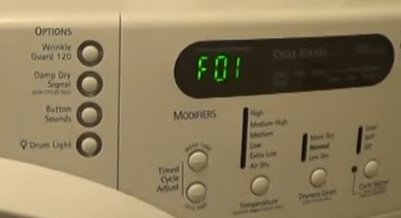
In simple terms, when you see the F1 error code on your GE dryer, it’s like your dryer is raising its hand and saying, “Hey! I’ve got a bit of a problem here!” This particular code typically indicates that there’s an issue with the dryer’s control board, which is like the brain of the appliance — sort of like when your computer gets a glitch and stops working properly. The control board manages all the functions of your dryer, from starting the cycle to making sure everything dries just right. So, when it’s not working correctly, neither will your dryer.
Understanding the Significance of the F1 Error Code
The F1 error code often baffles people because it’s one of those things that isn’t immediately clear. You might even be tempted to think it’s something like a secret spy code, but rest assured, it’s not that mysterious once you break it down. So, why does this happen? You see, your dryer is equipped with sensors and electronic components that monitor and control various elements of its operation. When these components detect an anomaly, they alert you via error codes to prevent further damage or inefficient functioning.
Think of the F1 code as a caution sign on the road. It doesn’t mean your vehicle is about to explode, but it does signal that you should tread carefully and perhaps get some professional advice before proceeding. Most often, the F1 code points to a problem with the dryer’s control board circuitry or its connections. It might be due to something as simple as a loose wire, or it could be a more technical issue involving faulty elements within the board itself.
Now, you might be thinking, “Great, my dryer has a brain freeze; what should I do?” The first step is not to panic. Often, these sorts of electronics can be reset. Unplugging the dryer for a few minutes and plugging it back in sometimes clears the error. However, if the F1 code persists, it could be time to call in the experts who know these devices inside and out.
Common Causes and Troubleshooting Steps
Alright, here’s the deal: knowing what F1 means is half the battle. The other half is figuring out what caused it and how to fix it. Most homeowners can handle the basic troubleshooting without specialist help. But remember, safety first! Always make sure the appliance is unplugged before poking around.
First up, check the power supply. Believe it or not, sometimes the F1 error is just the dryer’s way of saying it needs a stronger, more stable energy source. Make sure your dryer is plugged into a dedicated outlet rather than an extension cord. If your connections seem firm and stable, yet the issue persists, it might be wise to check the control board next.
The control board is like the dryer’s command center. Issues here are like having a wonky GPS in your car that sends you down the wrong roads. If the board’s connections are loose, it might cause the dryer to behave unpredictably. Tightening these connections or ensuring that no corrosion has occurred can sometimes resolve the issue. Again, if you’re not comfortable with electronics, it’s perfectly okay to contact a professional to avoid any accidental damage.
Preventing Future Occurrences and Maintenance Tips
Now, let’s talk about preventing this nuisance from happening again. Maintenance is key. Regularly clean your dryer’s lint trap and vents to ensure it’s always in peak condition and not working harder than it needs to. Think of it like brushing your teeth — a little effort goes a long way in preventing bigger problems down the line.
Another useful tip is to make sure that your dryer is in a stable environment. Dryers that are exposed to high levels of humidity or extreme temperatures might experience more frequent issues with their control boards. A little like keeping a laptop away from your kiddie pool – some things just don’t mix well.
Finally, a regular check-up by a professional, much like a car service, can help catch potential issues before they spiral into bigger problems. This way, you can keep your dryer running smoothly and prevent that pesky F1 code from popping up unexpectedly.
In summary, seeing the F1 code might seem alarming at first, but it’s simply your dryer’s way of communicating a problem. By understanding what this code signifies and following a few troubleshooting and maintenance steps, you can get back to worry-free laundry days. If all else fails, don’t hesitate to seek professional help to avoid any unnecessary stress.